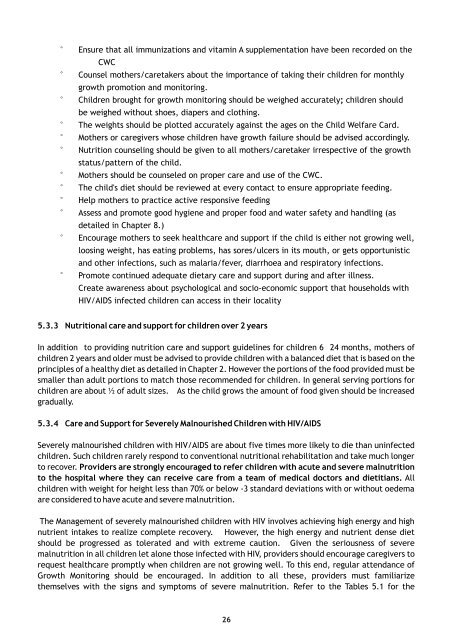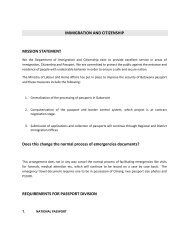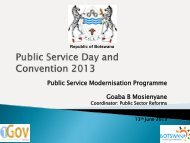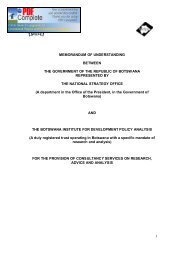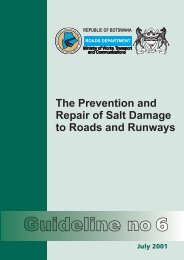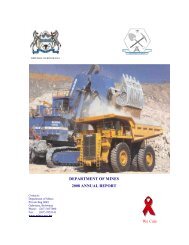National Nutrition and HIV/AIDS Guidelines for Service Providers of ...
National Nutrition and HIV/AIDS Guidelines for Service Providers of ...
National Nutrition and HIV/AIDS Guidelines for Service Providers of ...
You also want an ePaper? Increase the reach of your titles
YUMPU automatically turns print PDFs into web optimized ePapers that Google loves.
° Ensure that all immunizations <strong>and</strong> vitamin A supplementation have been recorded on the<br />
CWC<br />
° Counsel mothers/caretakers about the importance <strong>of</strong> taking their children <strong>for</strong> monthly<br />
growth promotion <strong>and</strong> monitoring.<br />
° Children brought <strong>for</strong> growth monitoring should be weighed accurately; children should<br />
be weighed without shoes, diapers <strong>and</strong> clothing.<br />
° The weights should be plotted accurately against the ages on the Child Welfare Card.<br />
° Mothers or caregivers whose children have growth failure should be advised accordingly.<br />
° <strong>Nutrition</strong> counseling should be given to all mothers/caretaker irrespective <strong>of</strong> the growth<br />
status/pattern <strong>of</strong> the child.<br />
° Mothers should be counseled on proper care <strong>and</strong> use <strong>of</strong> the CWC.<br />
° The child's diet should be reviewed at every contact to ensure appropriate feeding.<br />
° Help mothers to practice active responsive feeding<br />
° Assess <strong>and</strong> promote good hygiene <strong>and</strong> proper food <strong>and</strong> water safety <strong>and</strong> h<strong>and</strong>ling (as<br />
detailed in Chapter 8.)<br />
° Encourage mothers to seek healthcare <strong>and</strong> support if the child is either not growing well,<br />
loosing weight, has eating problems, has sores/ulcers in its mouth, or gets opportunistic<br />
<strong>and</strong> other infections, such as malaria/fever, diarrhoea <strong>and</strong> respiratory infections.<br />
° Promote continued adequate dietary care <strong>and</strong> support during <strong>and</strong> after illness.<br />
Create awareness about psychological <strong>and</strong> socio-economic support that households with<br />
<strong>HIV</strong>/<strong>AIDS</strong> infected children can access in their locality<br />
5.3.3 <strong>Nutrition</strong>al care <strong>and</strong> support <strong>for</strong> children over 2 years<br />
In addition to providing nutrition care <strong>and</strong> support guidelines <strong>for</strong> children 6 24 months, mothers <strong>of</strong><br />
children 2 years <strong>and</strong> older must be advised to provide children with a balanced diet that is based on the<br />
principles <strong>of</strong> a healthy diet as detailed in Chapter 2. However the portions <strong>of</strong> the food provided must be<br />
smaller than adult portions to match those recommended <strong>for</strong> children. In general serving portions <strong>for</strong><br />
children are about ½ <strong>of</strong> adult sizes. As the child grows the amount <strong>of</strong> food given should be increased<br />
gradually.<br />
5.3.4 Care <strong>and</strong> Support <strong>for</strong> Severely Malnourished Children with <strong>HIV</strong>/<strong>AIDS</strong><br />
Severely malnourished children with <strong>HIV</strong>/<strong>AIDS</strong> are about five times more likely to die than uninfected<br />
children. Such children rarely respond to conventional nutritional rehabilitation <strong>and</strong> take much longer<br />
to recover. <strong>Providers</strong> are strongly encouraged to refer children with acute <strong>and</strong> severe malnutrition<br />
to the hospital where they can receive care from a team <strong>of</strong> medical doctors <strong>and</strong> dietitians. All<br />
children with weight <strong>for</strong> height less than 70% or below -3 st<strong>and</strong>ard deviations with or without oedema<br />
are considered to have acute <strong>and</strong> severe malnutrition.<br />
The Management <strong>of</strong> severely malnourished children with <strong>HIV</strong> involves achieving high energy <strong>and</strong> high<br />
nutrient intakes to realize complete recovery. However, the high energy <strong>and</strong> nutrient dense diet<br />
should be progressed as tolerated <strong>and</strong> with extreme caution. Given the seriousness <strong>of</strong> severe<br />
malnutrition in all children let alone those infected with <strong>HIV</strong>, providers should encourage caregivers to<br />
request healthcare promptly when children are not growing well. To this end, regular attendance <strong>of</strong><br />
Growth Monitoring should be encouraged. In addition to all these, providers must familiarize<br />
themselves with the signs <strong>and</strong> symptoms <strong>of</strong> severe malnutrition. Refer to the Tables 5.1 <strong>for</strong> the<br />
26


